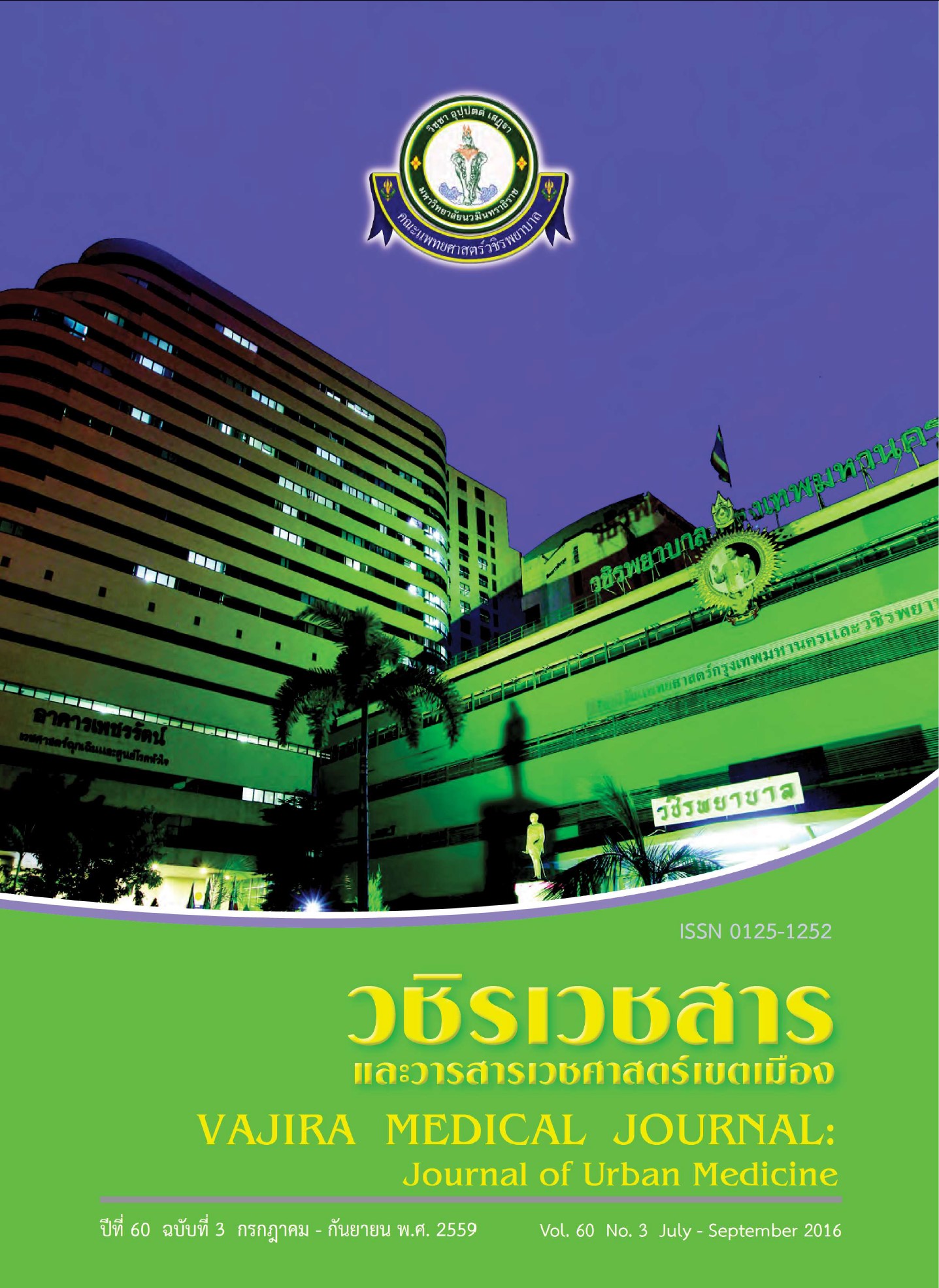Outcomes of Pharmaceutical Care in Tuberculosis Patients at Faculty of Medicine Vajira Hospital, Navamindrahiraj University
Main Article Content
Abstract
Objectives: To study the outcomes of pharmaceutical care in which the number of drug-related problems and knowledge of disease condition, medications, adverse drug reactions, and behavior of the tuberculosis patients.
Methods: This study was a retrospective descriptive study in new tuberculosis patients between October 2011 and May 2014. Each patient received pharmaceutical care during the treatment of tuberculosis. The outcomes were analyzed by descriptive statistics.
Results: There were 211 patients were enrolled in this study, (127 males, 60.2%). Drug-related problems were identified and classified into 5 categories which were adverse drug reactions (90 patients, 42.7%), overdosage (32 patients, 15.2%), subtherapeutic dosage (22 patients, 10.4%), drug interactions (30 patients, 14.2%) and untreated indications (8 patients, 3.8%). As for the tuberculosis patient’s knowledge of the disease condition, medications, adverse drug reactions, and their behavior, most of them (209 patients, 99.1%) were well-aware of importance of taking medications regularly, adhering to the follow-up appointment and monitoring adverse drug reactions.
Conclusion: Pharmaceutical care in this study shows that it can help identifying and solving the drug-related problems. It also can promote knowledge of the disease condition, medications, adverse drug reaction, and behavior of the tuberculosis patients. The successful outcomes of the tuberculosis treatment were consistent with those of the National Tuberculosis Program.
Downloads
Article Details
References
2. World Health Organization. Treatment of tuberculosis. Guidelines for National Programmes.4th ed. WHO/HTM/TB/ 2009.420. Geneva: World Health Organization, 2010. p. 30-49.
3. Bureau of Tuberculosis Department of Disease Control Ministry of Public Health. National Tuberculosis Control Program Guideline, Thailand, 2013. Bangkok: Printing office of The War Veterans Organization of Thailand Under Royal Patronage of His Majesty the King. p. 38.
4. Bureau of AIDS, TB and STIs, Department of Disease Control, Thailand Ministry of Public Health. Clinical practice guidelines of tuberculosis treatment in adult. Bangkok: Agriculture Cooperative Printing Authority of Thailand, 2011. p. 21-6.
5. Kerdnoo R. Impact of care program on cure rate of pulmonary tuberculosis patients at Prachuap Khiri Khan Hospital. [dissertation]. Nakhon Pathom: Silpakorn University; 2005.
6. Lorent N, Sebatunzi O, Mukeshimana G, Ende JV, Clerinx J. Incidence and risk factors of serious adverse events during antituberculous treatment in Rwanda: a prospective cohort study. J Acquir Immune Defic Syndr. 2011;13(1):32–7.
7. Singhahes R. Factors related to medication adherence among tuberculosis patients. [dissertation]. Chonburi: Burapha University; 2006.
8. Meesattayanan P. Factors effecting medication behavior in pulmonary tuberculosis patients. [dissertation]. Khon Kaen: Khon Kaen University; 1991.
9. Mekarungrungcharoen S. The pharmaceutical care for tuberculosis patients in tuberculosis clinic at Chaopraya-Apaiphubeth Hospital. [dissertation]. Bangkok: Chulalongkorn University; 1996.
10. Strand LM, Cippole RJ, Morley PC. Documenting the clinical pharmacist’s activities back to basics. Drug Intel Clin Pharm. 1998; 22: 63-7.
11. Helpler CD, Stand LM. Opportunities and responsibilities in pharmaceutical care. Am J Hosp Pharm. 1990; 47: 533-43.
12. Tatro DS. Drug interaction facts. St. Louis: Wolters Kluwer Health, Inc; 2011. p.1106.
13. Prosuree P. A Program to increase cure rate of tuberculosis in Namyuen Hospital, Ubon Ratchathani Province. J Health Sci. 2014; 23: 813-21.
14. Mekarungrungcharoen S. The pharmaceutical care for tuberculosis patients in tuberculosis clinic at Chaopraya-Apaiphubeth Hospital. [dissertation]. Bangkok: Chulalongkorn University; 1996. 180 ผลลัพธ์ของการบริบาลทางเภสัชกรรมแก่ผู้ป่วยวัณโรคในคณะแพทยศาสตร์วชิรพยาบาล มหาวิทยาลัยนวมินทราธิราช ปีที่ 60 ฉบับที่ 3 กรกฎาคม – กันยายน พ.ศ. 2559 วชิรเวชสารและวารสารเวชศาสตร์เขตเมือง กฤติมา โภชนสมบูรณ์
15. Skulchan T. The effect of pharmaceutical care for tuberculosis patients at the tuberculosis clinic in Yangchumnoi Hospital, Srisaket Province. [dissertation]. Ubon Ratchathani: Ubon Ratchathani University; 2008.
16. Krittiyanunt S, Sakulbamrungsil R,Wongwiwatthananukit S, Suthiputthanangoon W. Risk factors of anti tuberculosis drugs – induced hepatotoxicity in Thai patients. Thai J Pharm Sci. 2002; 26: 121-8.
17. World Health Organization. Treatment of tuberculosis. Guidelines for National Programmes. 4th ed. WHO/HTM/TB/2009.420. Geneva: World Health Organization, 2010. p. 60-3.
18. Bureau of AIDS, TB and STIs, Department of Disease Control, Thailand Ministry of Public Health. Clinical practice guidelines of tuberculosis treatment in adult. Bangkok: Agriculture Cooperative Printing Authority of Thailand, 2011. p. 24-5.
19. Kerdnoo R. Impact of care program on cure rate of pulmonary tuberculosis patients at Prachuap Khiri Khan Hospital. [dissertation]. Nakhon Pathom: Silpakorn University; 2005.
20. Thianchetsada W, Soontornpas C. Management and treatment outcome of patients with tuberculosis at Bankruad Hospital. IJPS 2012; 8: 41-52.
21. Kays MD. Tuberculosis. In: Koda-Kimble MA, Young LY, Alldredge BK, editors. Applied therapeutics:the clinical use of drugs. 10th ed. Philadelphia: Lippincott Williams & Wilkins; 2013. p. 1534-79.
22. Klasco RK, editor: DRUGDEX System (electronic version). Colorado, USA: Thomson Micromedex.[Cited 2016 May 20]. Available from: https://www.thomsonhc.com.
23. Hochadel M. Mosby’s drug reference for health professionals. 5th ed. St. Louis: Elsevier; 2016. p.1385.
24. Mafukidze A, Calnan M, Furin J. Peripheral neuropathy in persons with tuberculosis. J Clin Tuberc Other Mycobact Dis. 2016; 2: 5-11.
25. Nisar M, Watkin SW, Bucknall RC, Agnew RA.Exacerbation of isoniazid induced peripheral neuropathy by pyridoxine. Thorax. 1990; 45: 419-20.
26. Intaboonma J. Developing guideline for servicing tuberculosis patients in Chiandao Hospital.[dissertation]. Chiang Mai: Chiang Mai University; 2007.
27. Doncmmul P. Effecttiveness of implementing empowerment program on adherence to treatment regimen among persons with intensive phase of pulmonary tuberculosis, Lampang Hospital. [dissertation]. Chiang Mai: Chiang Mai University; 2012.


